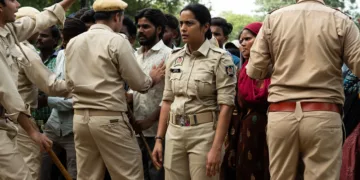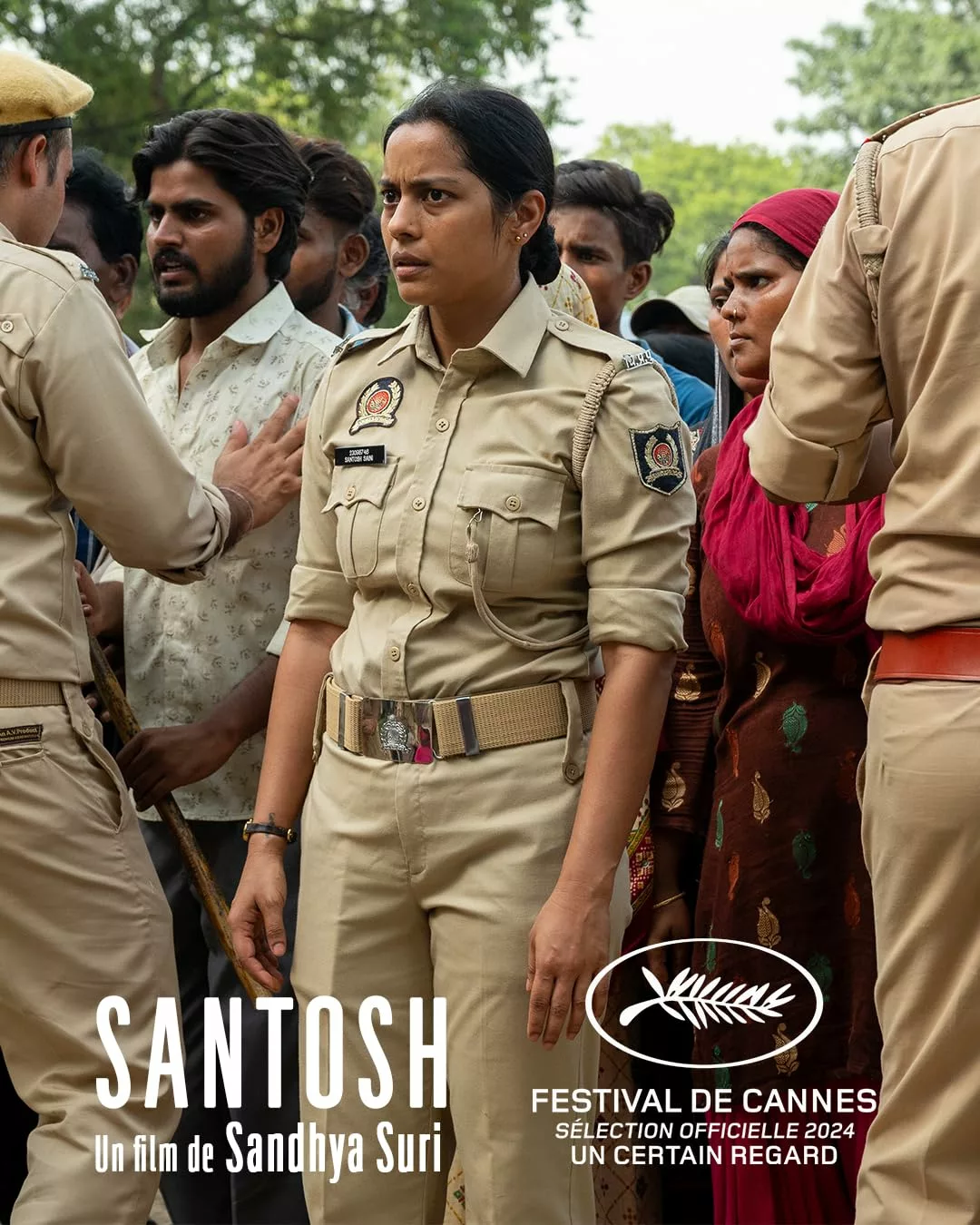Sandhya Suri’s debut feature film, Santosh, shines a light on the complex realities of law enforcement in rural India through the experiences of its titular character. Stepping into her late husband’s role as a police constable, young widow Santosh finds herself thrust into a world where corruption, prejudice, and brutality are everyday sights. Playing the part with nuanced sensitivity, Shahana Goswami brings Santosh’s quiet strength and evolving perspective to life.
Through Santosh’s eyes, we witness both the privileges and pressures that come with even a modest position of authority in a system designed to reinforce the status quo. Her growing awareness of injustice heightens with an investigation into the murder of a Dalit girl, as painful truths are dragged from the shadows.
Guiding Santosh is the experienced Inspector Sharma, portrayed with depth by Sunita Rajwar. Their relationship underscores the uneasy contradictions women face in navigating a male-dominated profession.
Suri’s observational approach immerses us in Santosh’s story without judgment, inviting reflection on complex themes still relevant today. Authentic performances and environmental shots of the local community breathe realism into difficult realities seldom captured on screen. By following one woman’s journey towards understanding, the film offers timely commentary on justice, power, and the subtle machinations that shape our shared humanity.
Relentless Pursuit of Justice
After unexpectedly inheriting her late husband’s job as a small-town police constable, Santosh soon finds herself plunged into a disturbing murder case. The young widow had only just begun navigating her new role in a system rife with corruption and prejudice. But when the body of a Dalit teenager is discovered in the countryside, Santosh must take on the difficult task of uncovering the truth.
Though dismissed at first, Santosh is one of the few who believes the girl’s low-caste family deserves to be heard. As protests erupt over police negligence, the case is handed over to seasoned Inspector Sharma. At the start, Santosh clashes with her brash superior. But Sharma takes a liking to Santosh’s dedication and grows sympathetic to the young woman’s ideals.
Together, the two women begin investigating the chilling crime. They work to overcome the indifference shown to Dalits and pressure from politicians to sweep the matter aside. Santosh is energized to solve the case and promote real justice, despite pushback from male colleagues happy with superficial solutions. But as the inquiry intensifies, so too do threats to Santosh and her reputation from those wishing to protect unfair hierarchies.
Along the way, Santosh’s friendship with Sharma brings new life experiences but also uncertainty. The senior officer’s guidance empowers Santosh, yet their bond remains enigmatic. Does Sharma sincerely support a reformed system or act in self-interest? As more is unearthed, Santosh faces difficult choices regarding allegiances and how far she’s willing to go for the truth.
Through it all, Santosh never loses sight of serving the girl’s grieving family. Even when oppression, bribery, and mob violence seem ready to defeat her relentless pursuit, her empathy and integrity refuse to surrender to an unfair status quo. But at what personal cost will justice for one Dalit life come?
Beneath the Uniform: Exploring Social Hierarchies
Santosh delves into the complex issues surrounding power in modern India. One of the primary themes examined is how power structures enable discrimination according to gender, caste, and religion. Santosh’s new position as a police constable initially seems empowering. But she quickly learns that even in her uniform, biases limit opportunities for many.
Dalits, for instance, have little chance of receiving help from authorities when seeking justice. Police dismiss the family for reporting the murdered girl’s disappearance. After outrage, they believe framing a convenient suspect will satisfy crowds, not the pursuit of truth. Santosh witnesses firsthand how the privileged view certain citizens as unworthy of dignity or care.
Her suspicions of corruption also reveal authority’s corruptible nature. Colleagues take bribes to overlook crimes or coerce false confessions. With no oversight, power corrupts or is wielded to oppress. While offering status, Santosh’s uniform also ties her to this flawed system that upholds inequities. She battles whether to conform or promote ethical change from within.
Inspector Sharma’s mentorship adds complexity, with unclear intentions that mirror life’s ambiguities. Her guidance grows Santosh’s skills but maintains the status quo. Is she preserving a world that grants her influence or sincerely helping another woman succeed? Their bond shows how complicated navigating power dynamics as minorities can be.
Ultimately, Santosh’s quest is for justice beyond surface solutions or advantages of rank. She strives to understand each person’s humanity and not make assumptions based on outward attributes. Beneath social uniforms, Santosh sees, lie shared hopes for dignity. By honoring the murdered girl and her family,maybe small cracks can form in oppression’s rigid veneer, suggesting a path to fairer, more compassionate societies.
Masterfully Capturing Societal Reflections
Sandhya Suri’s direction in Santosh achieves extraordinary authenticity. Rather than big Hollywood style, her approach is remarkably observational. Suri recruits mostly untrained local actors and places her camera right among everyday routines. This lends scenes an unforced realism, letting social nuances surface naturally through character interactions.
We feel fully immersed in Santosh’s world, thanks to Lennert Hillege’s observational cinematography. His camera seldom intervenes, simply following Santosh day-to-day. This grants experiences an intimate impact, giving weight to even fleeting moments. Hillege also has a knack for reaction shots. Santosh often silently processes confusing ethics, and through these glimpses into her mind, complex issues take shape.
Performances feel effortlessly lived-in because Suri’s actors simply respond as themselves. Shahana Goswami internalizes Santosh completely, leaving dialogue unneeded as her analytic eyes relay internal turmoil. Complex social themes permeate seemingly mundane routines through these extraordinarily natural performances. Sunita Rajwar matches her intangibly as senior officer Sharma; their bond conveys women’s diverse strategies for navigating male environments.
By embracing fly-on-the-wall realism over artificial techniques, Suri’s direction exposes socio-political intricacies quietly simmering below superficial small-town serenity. Her observational approach grants the film’s nuanced examination of injustice, discrimination, and abuse of authority remarkable verisimilitude and impact. Audiences are surely left thinking long after its final images fade.
A Study in Quiet Resilience
Shahana Goswami leads Santosh with a deeply moving yet understated performance. In the role of Santosh, a young widow thrust unexpectedly into police work, Goswami carries the film from start to finish. Through Santosh’s watchful eyes, we view this rural community and its unjust realities.
Goswami breathes profound heartache into Santosh’s still-raw grief. Yet she balances this with a steely resolve as Santosh navigates her new circumstances. We understand Santosh’s resilience comes from a place of desperation rather than choice. With just a subtle glance, Goswami conveys how Santosh’s gumption stems from a lack of other options.
As Santosh learns the true nature of law enforcement, Goswami subtly shifts her. Through analytical reactions, we glimpse Santosh’s perspectives changing in real-time. Her discomfort grows regarding colleagues’ sexism and corruption. Goswami ensures we fully feel Santosh’s internal transformations without relying on speeches.
In a climactic scene, Goswami maintains Santosh’s quiet nature yet unleashes her fury in a powerful moment of defiance. It’s a stunning display of the character’s journey thus far. Goswami grants Santosh glowing humanity, making her struggle for justice one we’re all invested in. She anchors the film with a performance so nuanced, we feel we know Santosh beyond what’s said.
Goswami also excels at expressing Santosh’s dynamic with role model Geeta. Their bond brings joy yet hints at underlying motives. Through subtle smiles and glances, Goswami conveys Santosh’s wish to believe in Geeta, despite healthy skepticism creeping in. She navigates this knotty relationship deftly.
In Goswami’s deeply empathetic hands, Santosh becomes our unwavering guide in this unflinching examination of injustice. She ensures we reflect long after on societal issues glimpsed through an ordinary woman’s resilient eyes. Goswami grants Santosh immortal humanity in one of global cinema’s most affectingly understated performances.
A Layered Allieship
Inspector Geeta Sharma brings further nuance to Santosh’s journey through Sunita Rajwar’s impactful work. After their initial friction, Sharma takes the young widow under her wing. But Rajwar injects questionable motives into their growing bond.
We detect empathy as Sharma guides Santosh’s nascent career. Yet hints of opportunism emerge. Is Sharma’s mentorship sincere or a means of molding this impressionable figure? Rajwar instills just enough ambiguity to ponder such questions.
Her guarded performance ensures we never fully understand Sharma. Rajwar conceals more than she reveals about this leading officer’s principles. We witness how Sharma’s authoritative persona was crafted in a system that is not yet accepting female leadership.
Through subtle exchanges, Rajwar shows Sharma taking pride in Santosh’s development. Yet her methods stray from the law at times, implicating Santosh in disturbing acts. Their relationship raises complex thoughts about women supporting one another within flawed institutions.
Rajwar builds an uneasy alliance that deepens Santosh’s disillusionment. She amplifies the film’s investigation of power dynamics between those privileged within broken systems and those lacking said positions. In doing so, Rajwar leaves us contemplating Sharma and her influence long after viewing.
A Debut Delivering Vital Insights
Sandhya Suri’s impressive first foray into fiction proves she is a director attuned to society’s faults. Santosh navigates complex issues around gender, caste, and authority with care and intelligence. Themes that remain tragically relevant in India and beyond.
Goswami fuels the film with her inward strength and growing disillusionment. We feel Santosh’s battles as our own, pulled towards justice but constrained by a flawed system. Side characters like brave Rajwar further layer the examination of influences on those in power.
Through it all, Suri keeps us focused on ordinary people’s lived realities, not sensational stories. Her vision resonates because it prioritizes authentic settings and performances. While injustices are real and painful, the film avoids cynical hopelessness.
Instead, it presents injustice as something transformable if societies truly listen to all voices. Like its namesake, Santosh leaves us wanting positive change through understanding different experiences. This impressive debut stimulates vital dialog and proves Suri is an emerging voice for meaningful change.
The Review
Santosh
Sandhya Suri's directorial debut, Santosh, proves a gripping and thoughtful examination of injustice in the real world. With grounded characters and timely themes, the film sticks with viewers long after by challenging preconceptions and sparking discussion.
PROS
- The complex and realistic character development of Santosh
- Nuanced exploration of themes like gender, caste, and authority in India
- Gripping plot that engaged viewers throughout
- Authentic performances and location filming
CONS
- Slow pace and length of over two hours at times
- Lack of ambiguity around the central case resolution
- Some scenarios felt unrealistic or forced.

















































